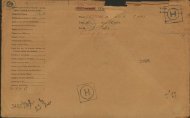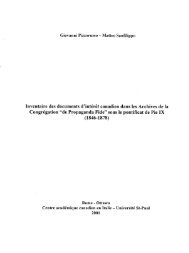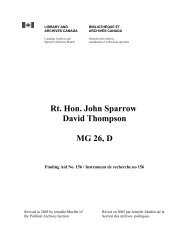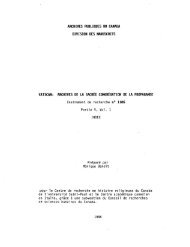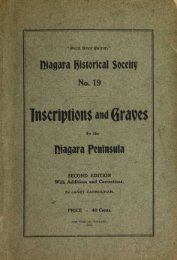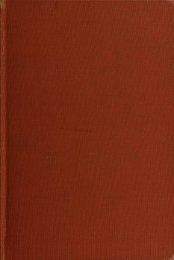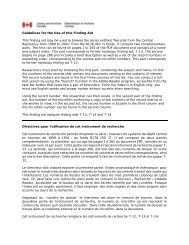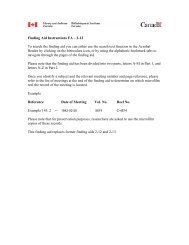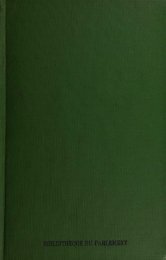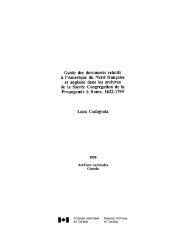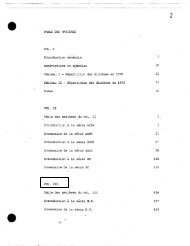Guide to Documents Relating to French and British North America in ...
Guide to Documents Relating to French and British North America in ...
Guide to Documents Relating to French and British North America in ...
Create successful ePaper yourself
Turn your PDF publications into a flip-book with our unique Google optimized e-Paper software.
VII. HOW TO USE A STANDARD ENTRY OF THE CALENDAR<br />
In the Calendar, each entry has a specific number with<strong>in</strong> its series (for example, Acta, 116,<br />
SOCG 213, Varia 202, Lettere 51, Congressi 105 1 ). Also, each series has been numbered: II, Acta; III,<br />
SOCG; IV, Varia <strong>and</strong> Addenda; V, Lettere; VI, Congressi. (Many m<strong>in</strong>or series have been regrouped<br />
under IV, Varia.)<br />
For each document, the series <strong>and</strong> subseries are provided. These are followed by the volume<br />
number <strong>and</strong>, when possible, the year or years the volume covers. In some cases, the time span<br />
<strong>in</strong>dicated for a volume corresponds only vaguely <strong>to</strong> the year or years covered by the records.<br />
The volume number is followed by all folios (or, more rarely, pages) of which the calendared<br />
document consists. Blanks are considered part of a document. For example, "ff. 99rv-100rv" means that<br />
the document consists of folios 99 <strong>and</strong> 100. On the other h<strong>and</strong>, "ff. 109rv, 112rv" means that the<br />
document consists of folios 109 <strong>and</strong> 112, but that folios 110 <strong>and</strong> 111 belong <strong>to</strong> another document. In<br />
the case of series where no <strong>in</strong>com<strong>in</strong>g documents are preserved (Acta, Lettere, Decreti, etc.), a document<br />
may consist of a portion of a folio only. For example, "ff. 82v-83r" means that the document appears<br />
on the verso of folio 82 <strong>and</strong> on the rec<strong>to</strong> of folio 83, but that the rec<strong>to</strong> of folio 82 <strong>and</strong> the verso of<br />
folio 83 belong <strong>to</strong> other documents.<br />
The above two k<strong>in</strong>ds of <strong>in</strong>formation, i.e., the title of the archival series <strong>and</strong> the volume number,<br />
are the only ones necessary when order<strong>in</strong>g a particular document <strong>in</strong> the archives of Propag<strong>and</strong>a. The<br />
sub-series need only be specified <strong>in</strong> the case of the Congressi series. Folio (or page) numbers are then<br />
necessary <strong>to</strong> locate the document with<strong>in</strong> the selected volume.<br />
Next, the language used <strong>in</strong> the document is shown. In the case of <strong>in</strong>com<strong>in</strong>g documents perta<strong>in</strong><strong>in</strong>g<br />
<strong>to</strong> <strong>North</strong> <strong>America</strong>, most are written <strong>in</strong> Italian <strong>and</strong> Lat<strong>in</strong>, although some are <strong>in</strong> <strong>French</strong>, Spanish <strong>and</strong><br />
English. Incom<strong>in</strong>g documents written <strong>in</strong> a language other than Italian (sometimes even <strong>in</strong> Lat<strong>in</strong>) were<br />
usually translated <strong>in</strong><strong>to</strong> Italian by the foreign clergy's agents resid<strong>in</strong>g <strong>in</strong> Rome for circulation among<br />
Propag<strong>and</strong>a officials. Some of these translations are still attached <strong>to</strong> the orig<strong>in</strong>al documents. Most of<br />
Propag<strong>and</strong>a's outgo<strong>in</strong>g documents were written <strong>in</strong> Italian or Lat<strong>in</strong>, although occasionally we f<strong>in</strong>d letters<br />
<strong>in</strong> <strong>French</strong>. Although the core of the document is usually <strong>in</strong> one language only, often notes were<br />
scribbled on the orig<strong>in</strong>al document or citations were made that were <strong>in</strong> another language. Sometimes<br />
a s<strong>in</strong>gle entry may consist of up <strong>to</strong> three different languages.<br />
Each entry conta<strong>in</strong>s his<strong>to</strong>rical <strong>in</strong>formation on the document. This <strong>in</strong>formation varies accord<strong>in</strong>g<br />
<strong>to</strong> the nature of the archival series. In Acta, be<strong>in</strong>g a collection of proceed<strong>in</strong>gs of the "Congregazioni<br />
Generali" (General Congregations), only the place where the meet<strong>in</strong>g was held (<strong>in</strong>variably Rome) <strong>and</strong><br />
the date of the meet<strong>in</strong>g are <strong>in</strong>dicated. In Lettere, be<strong>in</strong>g registers of copies of letters written by<br />
Propag<strong>and</strong>a officials, dates of outgo<strong>in</strong>g letters are clearly stated. The only notable exception is vol. 275,<br />
where days are usually absent. The place of orig<strong>in</strong> is nearly always Rome (though this is seldom<br />
openly stated). Letters registered <strong>in</strong> vols. 276-277, however, were mostly written <strong>in</strong> Padua or Venice.<br />
Dates of both Acta <strong>and</strong> Lettere, as is the case for all Propag<strong>and</strong>a's <strong>in</strong>ternal or outgo<strong>in</strong>g documents, are<br />
given accord<strong>in</strong>g <strong>to</strong> the New Style calendar (Calendario Gregoriano). Seldom do Propag<strong>and</strong>a's letters<br />
<strong>in</strong>dicate the name of the person who signed the orig<strong>in</strong>al, even though this was, most often, the prefect<br />
or the secretary of the Congregation.<br />
Entries relat<strong>in</strong>g <strong>to</strong> series of <strong>in</strong>com<strong>in</strong>g documents (SOCG, Congressi, etc.), show the names of the<br />
sender(s) <strong>and</strong> of the addressee(s), edited accord<strong>in</strong>g <strong>to</strong> modern st<strong>and</strong>ard usage, usually <strong>in</strong> the language<br />
of the country of orig<strong>in</strong>, followed by a short <strong>in</strong>dication of their capacity at the time when the letter<br />
was written. Obviously, not all <strong>in</strong>com<strong>in</strong>g documents are letters. In the case of books, pamphlets or<br />
pr<strong>in</strong>ted matter <strong>in</strong> general, their author is given. Entries show the day, month <strong>and</strong> year <strong>in</strong> which the<br />
75



